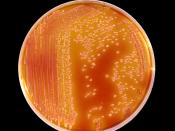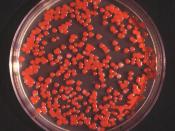SERRATIA MARCESCENS
Serratia marcescens is a pathogen that at one time, was considered to be harmless. However, testing conducted in the 20th century accidentally revealed just the opposite. The pivotal study called "Operation Sea Spray" was conducted in the early 1950's. The United States Army was testing how wind currents affected the spread of biochemical weapons. Giant balloons were filled with Serratia marcescens and floated over the city of San Francisco. The balloons were subsequently burst and the supposed harmless Serratia marcescens was released over the city. Within a matter of days, markedly high increases in pneumonia and urinary tract infections were reported by local doctors. Serratia marcescens was no longer thought to be innocuous.
Serratia marcescens is actually a hostile pathogen. A pathogen is an agent that causes disease or infection. Pathogens can usually be identified by their ability to metabolize lactose. Fermenters of lactose are non-pathogenic and non-fermenters are pathogenic.
Anti-pathogenic agents, called antibiotics, are used to fight these diseases and infections. Antibiotics work by targeting special diseased cells and not healthy life-sustaining cells. Each antibiotic is usually able to fight one type of organism. Two examples are of antibiotics are Tetracycline and Streptomycin.
The ubiquitous Serratia marcescens is a member of the family Enterobactieriaceae. Members of this family are known to be some of the most pathogenic and common organisms encountered in microbiological studies. These bacteria are gram negative, rod shaped, and are most commonly seen causing intestinal infections. Although usually found in the intestine, they are also found in most natural habitats. Some other sicknesses caused by these organisms are: Meningitis, Bacillary Dysentery, Typhoid, and food poisoning. Since many of the species in this family are very much alike, biochemical tests are necessary to differentiate among them. Laboratory tests used to differentiate among the species are...


